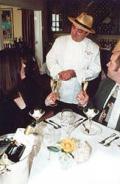By day's end, I'm happy to report, I was a bona fide convert. My expectations of uninspired wineries, prosaic tour guide banter and an uncomfortable, crowded tour bus were misplaced. Not only did we get our fill of flavorful wines, but we also had time to stop at some famous San Francisco sights, experience California's majestic redwoods and even get up close and personal with a llama.
While independent touring of California's wine country is still the best way to experience the area, a guided visit offered by any one of a number of San Francisco tour companies is an ideal way to get a feel for Napa and Sonoma when time is limited and you'd rather not swirl, sip and drive.
My sister - who had never before visited the wine country - and I chose to break away from a family vacation in San Francisco to take the wine country side trip, which also included a visit to the nearby Muir Woods National Monument.
That was a real plus for me, because I had always wanted to see the giant redwoods that inhabit Muir Woods but had never made it there. (My husband and I once made a detour from a Bay Area road trip to see the woods, but when we couldn't find any parking, we decided to leave.)
Another reason to include Muir Woods in your tour is because only vans are used to transport groups there, which limits the size to no more than 12 or 13 people.
Our tour guide, with San Francisco-based Extranomical Adventures, picked us up right on time in front of our hotel, and within minutes we were at San Francisco's Palace of Fine Arts, built in 1915 for the Panama-Pacific International Exposition. Situated in an inviting park setting, the classic Roman rotunda and curved colonnades made for some good picture-taking.
No time, though, for a visit. We had to be on our way to Muir Woods, located just 12 miles from the Golden Gate Bridge, but four of those 12 miles consist of hairpin curves that will take you through fog on a two-lane road that ascends steeply. The fog may make for a more frightful drive, but it's key to the survival and growth of the trees, which rely on the fog's moisture during dry summer months.
A primeval old-growth coast redwood forest, Muir Woods was set aside as a national monument through a gift by philanthropist and congressman William Kent, who donated, with his wife Elizabeth, 295 acres to the federal government. Now occupying 560 acres, the park was named after conservationist John Muir at Kent's request.
While our time was limited, we had about 45 minutes to wander through the woods and inspect close up the mammoth trunks of these coastal behemoths, some of which reach heights of up to 265 feet.
It's a good idea to shoot photos of the trees with people standing in front of them in order to show the perspective of their enormous girth. Some of the trunks at their base have diameters of as much as 14 feet.
Because of our short time there, I'd definitely advise a return to Muir Woods, where there are more than a half-dozen trails to explore, one of which leads to the Pacific Ocean at Muir Beach.
By 11:15, we were on our way to the star attraction of the day: the famed wineries of Sonoma. One thing I appreciated about this tour is that the wineries we visited were selected precisely because they're smaller boutique operations, which translates into warmer, friendlier service.
By necessity, all three wineries are located in Sonoma's Carneros region, which is the area closest to San Francisco. Our French-born guide reminded us we were going to the more rustic-feeling Sonoma Valley instead of its stuffier rival, Napa, where, as he put it, "they have an attitude. They want to charge you $15 for a tasting. There are no free tastings."
Ours, by contrast, were all complimentary, with the exception of a $1 tasting of a 2003 award-winning cabernet, paired with a piece of dark chocolate.
Our first stop was Cline Cellars, a small production winery that sits on 350 acres, 200 of which are planted in merlot, chardonnay, pinot noir, pinot gris and syrah. Cline produces roughly 150,000 cases of wine a year.
There's a fun, whimsical feel to the winery, where you're greeted at the entrance by a mannequin of a pudgy-looking man, dressed in a denim shirt, bow tie, and cummerbund and grasping a bottle of wine.
Standing outside under a canopy of trees, we were treated to tastes of five wines, including a light and fruity pinot grigio, which we were told is excellent when paired with seafood or Thai dishes; a smoky-tasting syrah; a red table wine; and a zinfandel, for which the winery is best known.
The maternal grandfather of winery owner Fred Cline was Valeriano Jacuzzi, who founded the famous spa company with his brothers. The Cline family is currently building a winery across the road from Cline Cellars, which will be named in honor of the Jacuzzi family and will specialize in Italian varietals.
"We're a working winery where guests can actually see the grapes come in in the big bins after being picked and dumped into the stemmer crusher," Becky Larson, wife of winemaker Tom Larson, explained in a telephone interview. "They can also see the forklifts driving around, so they find that interesting."
Visitors to the winery will feel almost as though they're dropping in on the family. You'll get to see the family's pet llama named Dolly, their three Jacob sheep and Sunny, their yellow Lab. When we were there, the Larsons' 6-year-old twin sons were selling lemonade outside.
Before sampling our flight of six wines, we were given a quick primer on the proper way to taste. We were instructed to hold the glass by the stem, tilt it to get a good look at the wine's color, swirl it, then sip the wine while swishing it around on the tongue.
"Never judge on the first sip, take two sips," we were advised.
Among the wines we tasted was a 2003 cabernet that had just been dubbed the top California cab at the California State Fair.
Almost all the wine bottles at Larson are sealed with screw-tops because cork is too expensive and can potentially taint some of the wine, explained our tasting room guide.
"It can get into your wine and it will smell like wet dog," she said.
Our final winery - and my least favorite - was Viansa Winery and Italian Marketplace, a magnet for tourists but far too commercial for my taste. The two winery workers leading the tasting while we were there engaged in what felt like scripted shtick that proved to be more annoying than entertaining, all the while heavily promoting membership in their tasting club.
The sweeping views of the vineyards and olive trees from Viansa's hilltop location, though, are a crowd-pleaser, recalling the beauty of Italy's Tuscan region. Founded by Sam and Vicki Sebasatiani, the winery produces about a dozen Italian varietals, as well as a number of California vintages. While I would not have minded skipping the winery entirely, I was apparently in the minority in our tour group.
Besides the three wineries, the tour also includes brief stops at Sonoma Plaza, the local town square where you can visit a number of shops, as well as the historic mission and the old Sonoma Barracks, built in 1836 to house Mexican solders.
We also squeezed in a lunch break at the Sonoma Cheese Factory and, on our way back to San Francisco, we stopped in Sausalito and a viewpoint at the Marin Headlands, where we had a close-up view of the fog-shrouded Golden Gate Bridge and the city skyline.
By the time we arrived back at our hotel after 5 p.m., I thought I'd had my fill of wine. But as I made my way to the elevator to go up to my room, I noticed that the hotel's complimentary wine reception had not yet ended.
And so I indulged. After all, what better way to practice my wine-tasting basics.



